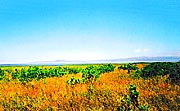Kostanai District
Districts of Kazakhstan
 To many, Kostanai District is associated with the concept of the "virgin lands" campaign. Today it is the largest grain supplier in Kazakhstan. The district also has well-developed processing and food industries, and is one of the largest in Kazakhstan. It is located at the junction of the Ural Mountains, West Siberian Plain and Turgai Plateau. The largest rivers flowing across Kostanai district are the Tobol and Turgai. The Tobol River is of the most interesting because of the many legends associated with it.
To many, Kostanai District is associated with the concept of the "virgin lands" campaign. Today it is the largest grain supplier in Kazakhstan. The district also has well-developed processing and food industries, and is one of the largest in Kazakhstan. It is located at the junction of the Ural Mountains, West Siberian Plain and Turgai Plateau. The largest rivers flowing across Kostanai district are the Tobol and Turgai. The Tobol River is of the most interesting because of the many legends associated with it.
Especially popular with local residents are such activities as gathering mushrooms and berries, hunting and fishing. In winter people like skiing; and in summer - hiking and camping. Kostanai City is the administrative, trade, industrial, social and cultural center of the district. It is situated in the steppe zone, on the banks of the Tobol River. Its population is 223,600 people or 22% of the total population of the district. There are four more large settlements in the area: Rudnyi, Lisakovsk, Zhetyraga and Arkalyk, the former administrative center of Turgai District.

Kostanai is one of the largest industrial and cultural centers of northern Kazakhstan. It is situated on the left bank of the Tobol River. Russian and Ukrainian peasant-settlers founded it in 1879. From 1893 Kostanai has been the main center of Turgai District, where annually two fairs are held. Kostanai is the Motherland of the Kazakh scholar Ibrai Altynsarin (1841-1889). Meat canning factories, confectioneries, and shoe-manufacturing and sewing factories represent the light and food industries.
Arkalyk as a town was founded in 1956 with the development of the extraction of bauxite deposits. Nearby is Naurzumsky preserve, which was founded in 1931. It is situated 250 km south of Kostanai, not far from the Kostanai-Arkalyk motorway. The center of the Naurzumsky preserve is Dokuchaevka village, so named in 1946 in honor of the Russian naturalist V. V. Dokuchayev. It is a migratory zone for Turgai birds. During the mass migration of birds in spring, more than 150 species of birds can be seen.
